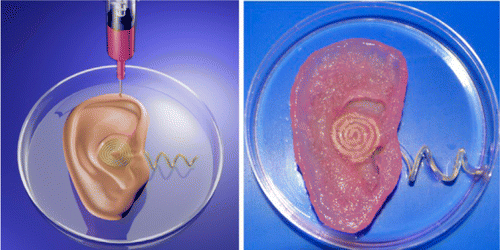牛细胞3D打印仿生耳 可清晰收传声音
| 导读 |
靠着 1 台 3D 打印机、1 个培养皿、加上一些牛细胞,美国研究人员正在培养不只可以接收声音,还可以把声音传出去的人工耳朵。
普林斯顿大学(Princeton University)科学家将混入液体胶状物的牛只细胞传送到打印机,再送入微小的银粒子,打印机接着把材料印成形,制造出“生物耳” ,... |

靠着 1 台 3D 打印机、1 个培养皿、加上一些牛细胞,美国研究人员正在培养不只可以接收声音,还可以把声音传出去的人工耳朵。

3D 耳朵设计的用意不在取代人耳,而是要探索结合电子与生物材料的新方法。
领导这项研究的教授麦卡宾(Michael McAlpine)表示:“我们这里实际在做的,比较像是证明 3D 印刷能力的概念,因为多数人是利用 3D 打印机来打印被动物件。”
3D 耳打印成形时,呈柔软与半透明状。耳朵放着培养 10 周,让细胞增生呈肉色,在天线周边形成坚硬的细胞组织。
研究人员透过连结耳后的电极,展示电线接收无线电讯号的能力。他们朝一对培养完成的耳朵播放贝多芬的《献给爱丽丝》(Fur Elise),电极将讯号透过电线输出到喇叭,播出的音乐清晰无杂讯。
原文链接:
3D Printed Bionic Ears
The ability to three-dimensionally interweave biological tissue with functional electronics could enable the creation of bionic organs possessing enhanced functionalities over their human counterparts. Conventional electronic devices are inherently two-dimensional, preventing seamless multidimensional integration with synthetic biology, as the processes and materials are very different. Here, we present a novel strategy for overcoming these difficulties via additive manufacturing of biological cells with structural and nanoparticle derived electronic elements. As a proof of concept, we generated a bionic ear via 3D printing of a cell-seeded hydrogel matrix in the anatomic geometry of a human ear, along with an intertwined conducting polymer consisting of infused silver nanoparticles. This allowed for in vitro culturing of cartilage tissue around an inductive coil antenna in the ear, which subsequently enables readout of inductively-coupled signals from cochlea-shaped electrodes. The printed ear exhibits enhanced auditory sensing for radio frequency reception, and complementary left and right ears can listen to stereo audio music. Overall, our approach suggests a means to intricately merge biologic and nanoelectronic functionalities via 3D printing.
来源:bio360
 腾讯登录
腾讯登录
还没有人评论,赶快抢个沙发